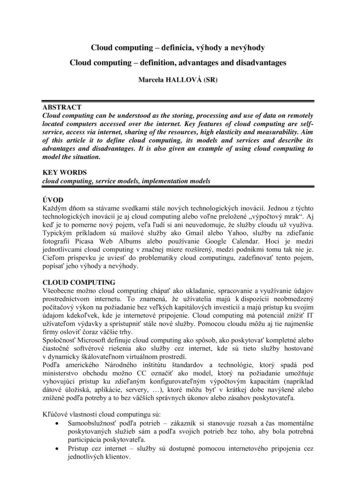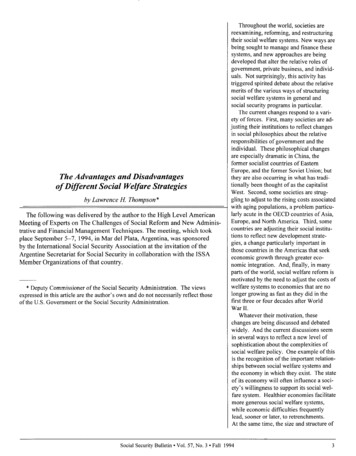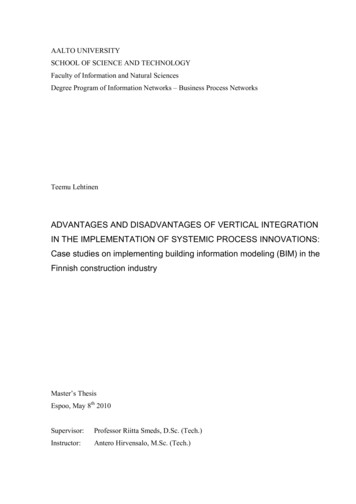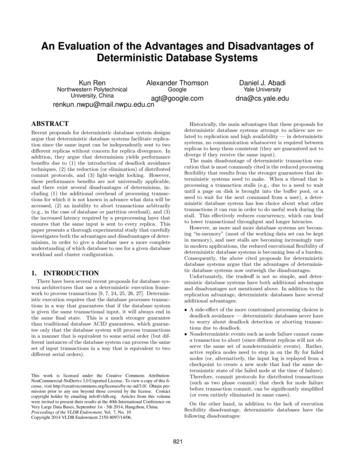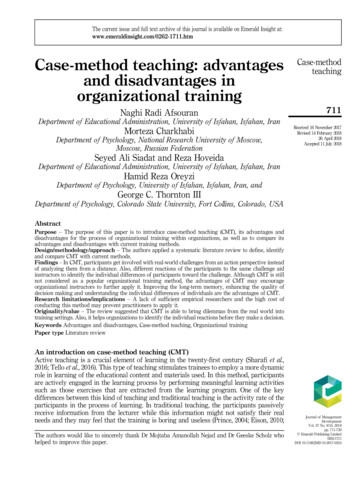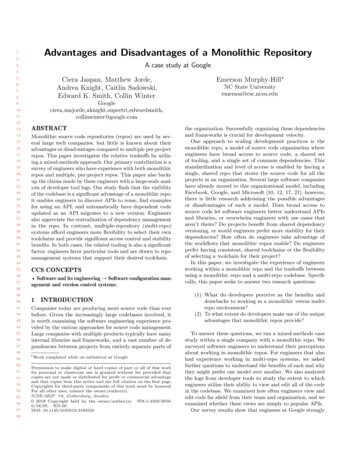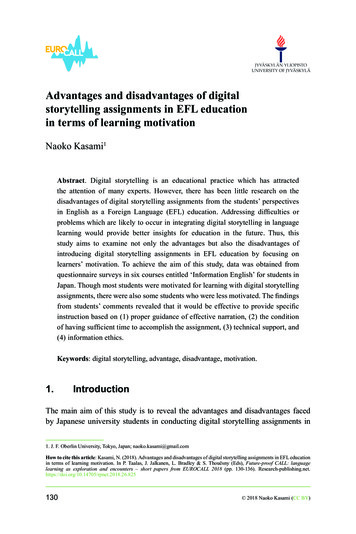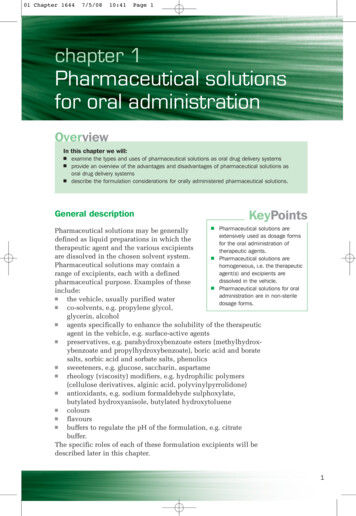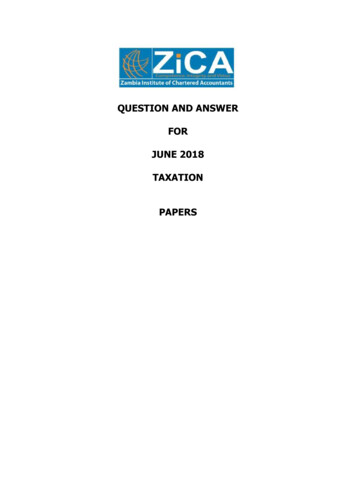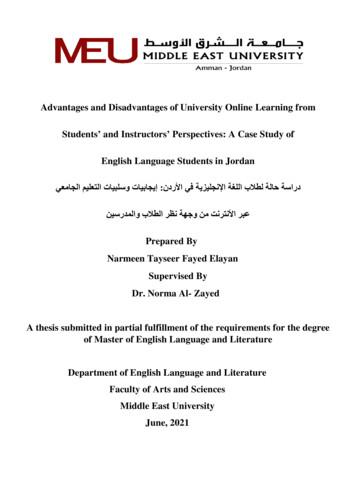
Transcription
Advantages and Disadvantages of University Online Learning fromStudents’ and Instructors’ Perspectives: A Case Study ofEnglish Language Students in Jordan إيجابيات وسلبيات التعليم الجامعي : دراسة حالة لطالب اللغة اإلنجليزية في األردن عبر األنترنت من وجهة نظر الطالب والمدرسين Prepared ByNarmeen Tayseer Fayed ElayanSupervised ByDr. Norma Al- ZayedA thesis submitted in partial fulfillment of the requirements for the degreeof Master of English Language and LiteratureDepartment of English Language and LiteratureFaculty of Arts and SciencesMiddle East UniversityJune, 2021
IIAuthorization
IIIThesis Committee Decision
IVAcknowledgmentsFirst of all, I would like to thank Allah, the Almighty, who gave me patient andstrength to finish my thesis.I would like to thank my supervisor, Dr. Norma AL Zayed for her support,encouragement, and effort.I also would like to thank express my gratitude to my friends Rawsan and Sara.
VDedicationThis thesis is dedicated to my family who supported me and motivated me tocomplete my thesis despite the difficulties I faced.
VITable of ContentsSubjectPageAuthorization ---------------- IIThesis committee decision -- IIIAcknowledgements ---------- IVDedication --------------------- VTable of contents ------------- VIList of tables -------------------- IXList of appendices ------------- XIEnglish abstract ---------------- XIIArabic abstract ------------------- XIIIChapter One: Introduction1.0. Background of the Study ---- 11.1. Statement of the Problem ---- 41.2. Objectives of the Study ------- 51.3. Questions of the Study --------- 51.4. Significance of the Study ------- 51.5. Limitations of the Study -------- 61.6. Limits of the Study --------------- 6
VII1.7. Definitions of Terms --------------- 6Chapter Two: Literature Review2.0. Introduction --------------------- 82. 1. Review of Theoretical Literature -------------------------------------------- 82. 2. Empirical Studies ------------ 11Chapter Three: Methods and Procedures3.0. Introduction -------------------163.1. Methods of the Study -------- 163.2. Population and Sample of the Study ----- ------------------------------------ 163.3. Instruments of the Study ------ 173.3.1 Questionnaires of the Study - 173.4. Validity of the Instruments --- 183.5. Reliability of the Instruments - 183.6 Procedures of the Study --------- 19Chapter Four: Findings of the Study4.0. Introduction ----------------------- 204.1. Results of the First Question --- 204.2. Results of the Second Question -------------------------------------------------- 34
VIIIChapter Five: Discussion, Conclusion, and Recommendations5.0. Introduction ----------------------- 475.1. Discussion of the results of the first question ----------------------------------- 475.2. Discussion of the results of the second question -------------------------------- 495.3. Conclusion ------------------------- 505.4. Recommendations ----------------- 51References ------------------------------ 52Appendices ------------------------------- 56
IXList of TablesChapter Number-DescriptionTable Number4-1PageNo.The Distribution of the Respondents (Students) In The Study21Sample According to Their Demographic Data4-2The Arithmetic Mean and Standard Deviations of the22Respondents' Answers About the Dimensions of theAdvantages and Disadvantages4-3Technical Problems of University Online Learning234-4Educational Problems of University Online Learning254-5Assignments and Evaluations of University Online Learning304-6Others324-7The Distribution of the Respondents (Instructors) In The Study34Sample According to Their Demographic Data4-8The Arithmetic Mean and Standard Deviations of the36Respondents' Answers About the Dimensions of theAdvantages and Disadvantages4-9Technical Problems of University Online Learning37
XChapter Number-DescriptionTable NumberPageNo.4-10Educational Problems of University Online Learning384-11Assignments and Evaluations of University Online42Learning4-12Others45
XIList of reInstructors’QuestionnairePanel of Experts56BC6268
XIIAdvantages and Disadvantages of University Online Learning fromStudents’ and Instructors’ Perspectives: A Case Study ofEnglish Language Students in JordanPrepared ByNarmeen Tayseer Fayed ElayanSupervised ByDr. Norma Al- ZayedAbstractThis study aims at exploring the advantages and disadvantages of universityonline learning from students’ and instructors’ perspectives. So that the researcherused the quantitative approach. The questionnaire was distributed to the students andinstructors of the English Department in Middle East University to represent thequantitative data. The sample of the study was eighty-six students and twenty-nineuniversity instructors from the English Department at Middle East University whoparticipated in the questionnaire. This study revealed that the advantages ofuniversity online learning from students’ perspectives are using online for Englishlearning is more interesting than the traditional method and ease of handing overassignments while the disadvantages of university online learning from students’perspectives are high costs of internet services, online learning is not suitable forevery topic and online learning requires the submission of a lot of duties andactivities. The advantages of university online learning from instructors’perspectives are easy to access to online learning platforms, online lectures can berecorded, archived, and shared for future reference, the exams correspond to thematerials presented during the lectures, whereas the disadvantages of universityonline learning from instructors’ perspectives are online learning requires theinstructors to have a basic understanding of using digital forms of learning andonline learning lacks credibility in exams and needs better time management.Keywords: Online learning, Advantages and Disadvantages, Students’perspectives, Instructors’ Perspectives
XIII دراسة حالة لطالب اللغة اإلنجليزية في األردن : إيجابيات وسلبيات التعليم الجامعي عبر األنترنت من وجهة نظر الطالب والمدرسين إعداد نارمين تيسير فايض عليان إشراف د . نورما الزايد الملخص تهدف هذه الدراسة إلى استكشاف إيجابيات و سلبيات التعليم الجامعي عبر اإلنترنت من وجهة نظر الطالب والمدرسين . بحيث استخدم الباحث المنهج الكمي . تم توزيع االستبيان على طالب ومعلمي قسم اللغة اإلنجليزية في جامعة الشرق األوسط لتمثيل البيانات الكمية . كانت عينة الدراسة ستة وثمانين طالبًا وتسعة وعشرين معل ًما جامعيًا من قسم اللغة اإلنجليزية بجامعة الشرق األوسط شاركوا في االستبيان . كشفت هذه الدراسة أن ايجابيات التعليم الجامعي عبر اإلنترنت من وجهة نظر الطالب هي أن استخدام اإلنترنت لتعلم اللغة اإلنجليزية هو أكثر إثارة لالهتمام من الطريقة التقليدية وسهولة تسليم المهام بينما سلبيات التعليم الجامعي عبر اإلنترنت من وجهة نظر الطالب هي ارتفاع تكاليف خدمات اإلنترنت ، التعليم عبر اإلنترنت ليس مناسبًا لكل مواضيع ، ويتطلب التعليم عبر اإلنترنت تقديم الكثير من الواجبات واألنشطة . ايجابيات التعليم الجامعي عبر اإلنترنت من وجهة نظر المدرسين هي سهولة الوصول إلى منصات التعليم عبر اإلنترنت ، يمكن تسجيل المحاضرات عبر اإلنترنت وأرشفتها ومشاركتها للرجوع إليها في المستقبل ، وتتوافق االختبارات مع المواد المقدمة أثناء المحاضرات ، في حين أن سلبيات التعليم الجامعي عبر االنترنت من وجهة نظر المدرسين هي أن التعليم عبر اإلنترنت يتطلب من المعلمين أن يكون لديهم فهم أساسي الستخدام األشكال الرقمية للتعلم ويفتقر التعليم عبر اإلنترنت إلى المصداقية في االختبارات ويحتاج إلى إدارة أفضل للوقت . الكلمات المفتاحية : التعليم عبر اإلنترنت ، المزايا والعيوب ، وجهات نظر الطالب ، وجهات نظر المدرسين
1Chapter One1.0. Background of the StudyThe covid-19 pandemic has forced the world into a series of changes in manyfields one of them is the educational sector. It compelled colleges and schools toclose down their campuses, as a result, that, online learning is considered aneffective approach to ensure continuity of education. So, the entire world isswitching to an online mode of educating and learning. Therefore, the viableutilization of video conferencing stages such as WebEx, ZOOM, and Google Meetas well as learning administration frameworks like Moodle, Chalkboard, etc., havebeen energized to back up students’ learning in all conceivable ways amid thepandemic (National statistical office, 2019).The educational sector has been affected by this pandemic widely too, andlike all universities of the world, Jordanian universities have shifted to onlinelearning and using platforms, applications, and tools like Moodle, Zoom,WhatsApp, and Microsoft teams as a learning management system. Online learningis an educational experience that does not associate with physical boundariesthrough this experience; students can take part in classes, participate in discussions,and interact with each other from any location. Consequently, characteristics ofonline learning include the use of a multimedia environment, the sharing of a widerange of information, the institution of an e-learning device enabling collaborativecommunication, the creation of a community for getting access to and disseminating
2information, and the incorporation of the systems on various sorts of operatingstructures and browsers (Oyarzun, Stefaniak, Bol & Morrison, 2017).On one hand, Online learning may have advantages, for instance, helpingstudents who cannot reach their classes to follow their schedule, better timemanagement, reduced costs, a more comfortable environment, improve technicalskills, and accessibility of time and place.On the other hand, the disadvantages of online learning might be, for example,limited feedback either during the lectures or during the dedicated office hours, alsoonline instructors tend to focus on theoretical courses, lack face to facecommunication between students and instructors sometimes the university studentsmight find that they are unable to work effectively, besides, online learning is notsuitable for every topic, for instance, complex topics or practices that require aphysical environment.Some problems that students and instructors might encounter in onlinelearning are lack of awareness of the society especially some students who do notknow how to use a computer, economic problems due to some students cannotprovide the cost for registration in online programs and paying the fees of thenetwork provides because of bad economic circumstance which Jordanian peopleare facing , lack of infrastructure, and self-motivation, students cannot communicateeffectively and completely with faculty and staff, lack of modern technologicaldevices, so students face a problem to meet up with some technical requirements ofonline learning, lack of adequate support of the government, poor interaction with
3instructors, the weak technological infrastructure of the institutions, instructorscannot cover all courses and achieve all educational goals, online learning requiresa double effort from instructors to facilitate the online learning process, and onlinelearning concentrates on theoretical courses. Moreover, the online infrastructure isconsidered as one of the great possible limitations that stop the adaption of onlinelearning (Aljaraideh & Al Bataineh, 2019).Mainly, online learning depends on the internet. So that it is considered as animportant way for communication as well as a research tool, which gives manyopportunities to communicate via several applications, and offers differentreferences in all fields too. People can reach any sort of data easily on the internet.Additionally, it is used for different purposes such as social, academic, andenjoyment purposes. Basically, the internet offers two essential benefits which arecommunication and information (Warren et. al., 1998).One of the major uses of the internet is education. it can be pointed out that theinternet has some uses, and these can be listed as information store, unlimitedcommunication, online interactive learning, online research, innovation in the newworld, learning development, and universal education (Park, 2009). Therefore, theinternet is an excellent way for students and researchers, it utilizes not only for socialconnection and entertainment but also for academic and scientific information. Inaddition, the use of the internet can improve the quality of education (Ciglaric et al.,1998). Moreover, the internet adds numerous positive changes to students and
4instructors. According to Dryli and Kinnaman (1996), the internet permits studentsto discover information as well as permitting them to think significantly andcreatively, to end up collaborative people and to solve a problem.Thus, the researcher aims to focus on the advantages and disadvantages ofuniversity online learning from students’ and instructors’ perspectives after theadaptation of online learning in Jordan for the first time due to the covid-19pandemic that affects the educational sector all over the world, also to maintain thesafety of students and faculty and the continuity of the educational process in alleducational institutions, in addition to preserve the access of all students to theireducational opportunity despite the exceptional circumstances that Jordan and allcountries of the world go through.1.1. Statement of the ProblemThis study concentrates on discovering the advantages and disadvantages ofuniversity online learning and clarifies the weaknesses that can be exploitedpositively to develop online learning based on the experience of the students andinstructors. Online learning has become an approved learning method that maintainsthe continuity of the educational process in all educational institutions and providesstudents with great flexibility in receiving education anytime and anywhere.Therefore, online learning has many advantages and disadvantages, but not alluniversity students can cope with the new method of learning.
51.2. Objectives of the StudyThis study aims at:1- Exploring the advantages and disadvantages of university online learning fromthe students’ perspectives.2- Exploring the advantages and disadvantages of university online learning fromthe instructors’ perspectives.1.3. Questions of the StudyThe study raises the following questions:1- What are the advantages and disadvantages of university online learning fromthe students’ perspectives?2- What are the advantages and disadvantages of university online learning fromthe instructors’ perspectives?1.4. Significance of the StudyOnline learning is a new way of learning and there are many studies on it, butthis study will help to find the solutions for the important problems that obstruct thelearning process. Additionally, through this study students and instructors candetermine what they need to increase the effectiveness of online learning. Moreover,the questionnaire of the study contains different problems that may serve as a toolfor further studies and uses to present different aspects that develop online learning.
6This study may benefit teachers, students, researchers, academic scholars, readers,and other people interested in education.1.5. Limitations of the StudyThe researcher cannot generalize the findings of this study to all universitiesin Jordan, as it is only limited to university students of English language at MiddleEast University. The results are restricted to Middle East University only.1.6. Limits of the StudyThis study was conducted at Middle East University in the second semesterduring the academic year 2020-2021.1.7. Definitions of TermsCoronavirus: according to Stoppler (2020) it is a type of frequent virus that infectshumans, usually main to higher respiratory contamination (URI.) Seven distinctivesorts of human coronavirus have been identified. The viruses are unfolded via theair through coughing and sneezing, close non-public contact, touching an object orfloor contaminated with the virus, and rarely, via fecal infection.Pandemic: according to Merriam-Webster's online dictionary pandemic is anoutbreak of an ailment that occurs over a wide geographic vicinity and affects a quitehigh share of the population.
7Online learning: it is defined theoretically by Anshari, Almunawar, Shahrill,Wicaksono & Huda (2017) as the method of instruction at a recognized institutionwhere the students do not get to go to classes on the campus. In the modern-daydigital era, the net has advanced as one of the indispensable abilities to shareresources for learning and research for both the instructors and the students.Internet: it is defined theoretically by the Second Edition of Oxford Dictionary asa world computer network offering a range of information and conversationfacilities, consisting of interconnected networks using standardized communicationprotocols.
8Chapter TwoReview of Literature2.0. IntroductionThis chapter consists of two parts: the first one is a review of theoreticalliterature and the second part is a review of some related empirical studies that havebeen conducted by researchers on the topic.2. 1. Review of Theoretical LiteratureThis part presents the theoretical studies that deal with the advantages anddisadvantages of university online learning from students’ and instructors’perspectives.Muir (2001) summarizes the advantages and disadvantages of online learningfrom students’ perspectives. The advantages of online learning are great dialoguecan be maintained due to the fact it is not restricted, there is a synergy between thelearner, instructor, and environment, there is extraordinary get admission to a largevariety of various resources. The disadvantages of online learning are barriers oftechnology that are associated to some things a computer virtually can't do such aslaboratory experiments, computer literacy students have extraordinary ranges offamiliarity with the computer, internet, and software programs, and lack of essentialonline features without the fundamental direction and learning styles which cannotbe entirely utilized and learning is limited.
9Simmons (2002) states that academic organizations are transferring towardsusing the internet for learning, both on campus and at a distance. For agencies andestablishments to do this orderly costly move, there needs to be an understandingthat the usage of online learning offers the most important advantages for instructorsand learners. For instructors, teaching could be achieved anywhere, anytime. Onlinematerials can be upgraded, and learners can see the modifications directly, it is alsodifficult for instructors to direct them to excellent information primarily based ontheir interests, desires, and needs to assign suitable materials for learners and toachieve our learning outcomes. For learners, online learning knows no time zones,in asynchronous online learning, college students can join the online materialsanytime, while synchronous online learning approves for face-to-face interactionbetween instructors and students. learners can speak with instructors about thematerials they are studying.Thurmond (2003) suggests the advantages of online learning from instructors’perspectives are the increasing quantity of online sources accessible through websuch as online journals and suitable websites supply a wealthy source for onlinelearners. Technology allows far-off groups to have interaction over the web onshared topics, and construct a sense of community even if students are many milesaway (An & Kim, 2006).According to Vonderwell, (2003) and Sit et. al (2005) face-to-face socialconnection is additionally lost in online learning. Lots of studies supported the viewthat lack face-to-face communication may also motive a feeling of loneliness and
11isolation amongst learners (Bullen, 1998; Hara and Kling, 2000; Zembylas et al.,2008). The largest disadvantage is lack of interaction while the largest advantage ofonline learning is flexibility and convenience (Cole, Shelley & Swartz, 2014).Restauri (2004) states that instructors want to start new administrative andorganizational methods which encounter the requirements of online learners.Instructors who employed technology in their online learning lecture rooms havecertain interests and needs. The provision of effective instructors all through thecourse creation process, as well as presentation and beyond, and high-quality of theeducation expertise. Courses viewed as essential for the assist of the online learninginstructor consist of updating technology training and academic design, pupiltraining from technical personnel, mentoring, and administrative support.Rovai et al., (2005), recommended that an energetic and strong social life oncampus can be “used to explain both high persistence and learning satisfaction anda lack of community and social communication in an online learning”. (Rovai, etal., 2005, p.4).Thomson (2010) mentions that online learning allows university students towork at a time and a place which well suits their learning interests and needs. Manyinstructors and learners commented on their awareness on the material of the courseand less on issues such as, traffic, parking, and exceptional troubles that can also appearwhen attending a traditional class environment. While Donlevy (2003) states onlinecoursework which tends to be studying and writing, deterring some learners. Studentswith low reading skills may also find the large textual content and writing to be heavy.
11Another difficulty of online learning is the absence of an instructor in a given time andplace.Liu (2014) confirmed that instructors also want to be conscious of universitystudents in online courses who are no longer self-regulated. Inexperienced people setdesires, expose and react in building the progress of their goals. Instructors can add thedeadlines and scheduling reminders to the internet classification assignment. They canspeak to the students about the importance of doing the reading comprehensionevaluation, and taking exams, but if the student is no more disciplined, then theinstructor is obliged to fail the student.2. 2. Empirical StudiesThis part deals with the experimental studies that are related to the advantagesand disadvantages of university online learning from students’ and instructors’perspectives.Browne (2003) carried out a research paper that aimed at the interaction amonginstructors and learners engaged on a Master's Degree delivered in online education.the use of normal quantitative and qualitative research methods, which is acquiredfrom the experience of a team of workers and students. The results perceiveadvantages to the learner when asynchronous verbal change presents time forviewed response. Moreover, benefits are recognized in the opportunity to reviewand practice. The creation of private networks that achieve the issues of the direction
12is identified and evaluated. Disadvantages are known with the technology itself andassociated troubles of access, and support.Park and Bonk (2007) examined a study that allowed eight students and fourdomestic college students interviewed to know the advantages and disadvantages ofonline learning and the use of web-based collaboration. It noted that learners’feedback and the interactions with peers and instructors are important, on the otherhand, time restriction and language problems perceived as disadvantages. However,some students feel they prefer to join with their peers and build some experience ofthe social environment.Oswald and Meloncon conducted two studies carried out in 2010 through theConference on College Composition and Communication (CCCC) Committee forbest practice in Online Writing Instruction (OWI). The first study focused oninstructors who taught fully online courses, whilst the second study viewedinstructors who taught blended courses. The information highlighted that there aredifficulties in registering students with disabilities in the instructors’ courses. Thestatement cleared that fifty-four percent of instructors referred to their course wasno longer accessible. Another obstacle that appeared in using the frequent subjectamongst instructors (twenty percent) was believed that the trouble ofaccommodating students with disabilities used to be not their duty. Instructorsadmitted that they lacked experience, the knowledge to meet the diagnosed desiresand interests of the students.
13Alexander, Truell, and Zhao (2012) investigated a study that pursuits to recordlearners’ beliefs of the benefits and negative aspects of studying courses online. Theparticipants for this empirical study comprised of university understudies enlisted ineleven segments of statistics frameworks given at a mid-sized, Midwestern college.The survey instrument was based on forty-three college students from a data systemscategory who furnished reasons for taking online courses. The two needfuladvantages of taking online courses as said by 80 percent of the members have beensatisfied, and flexibility. Almost 70 percent noted not having to sit down via lectures,the ability to review lectures in a lower cost (i.e. food, parking) would be animportant advantage of studying online courses. However, 60 percent citedadvantages of taking online courses would be much less stress with getting toclassification on time and finding parking; now not having to deal with specialstudents disrupting class, and no longer having to wait for different students (askingquestions) who work at a slower step. The three main disadvantages of studyingonline courses as known through about 70 percent of the student have been thepossibility to postpone of content material when no longer face-to-face with theinstructor, and increased strength for studying and learning. Over fifty percent statedthe chance of misunderstanding directions, anxiety, and stress when attempting tocall or contact the instructor, technology issues would be disadvantages for takingonline courses. Around 40 percent suggested predicted disadvantages of onlinecourses would be improved use of email and ease of cheating through differentlearners.
14Al-Alawneh (2013) examined a study that aimed at examining e-learningobstacles as perceived via faculty individuals of engineering faculties in Jordanianuniversities. A pattern of 176 college contributors involved with handing over onlinepublications used to be collected. The conclusion proved that greater educationcompanies wanted to have strategic plans that prompted the online courses.Tareen and Haand (2020) examined a study of University of Mara postgraduate students’ view of the advantages of online studying and figure out thenegative aspects of online teaching and learning. The study used a quantitativestrategy in which a survey questionnaire was once disbursed to University of Marastudents of Master in Education. The samples of the study consisted of 30participants who were made up of 22 full-time students and 8 part-time students.Results of the study revealed that online learning is suitable for scholar participation,and to the students’ needs and desires. Moreover, determined a lack of interactionamongst students, evaluation strategy, lack of unique feedback and resource fromlecturers.Kalal and Nayak (2020) conducted a study that pursuits on inspecting the viewof instructors and students about online classes. The participants of the studyconsisted of all the graduate and postgraduate college students and instructors fromdistinctive colleges in two cities. The evaluation was once carried out the usage ofthe data via two separate structured questionnaires for college students andinstructors in Dakshina Kannada and Udupi District in Karnataka. Data wererecorded and analyzed through the usage of descriptive statistics. The results
15revealed that college students are satisfied with online learning, and are gettingenough resources and information from instructors. It also finds that instructors aredealing with difficulties in conducting online lessons due to a lack of desirableeducation and development for establishing online classes. Technical issues are themain problem for the effectiveness of online classes.ConclusionTo conclude, the current study is different from other studies regarding thequestionnaire that pursuits not only to discover the benefits and negative aspects ofuniversity online learning from students’ and instructors’ perspectives but alsoexploring the technical,
online learning, lack of adequate support of the government, poor interaction with . 3 instructors, the weak technological infrastructure of the institutions, instructors cannot cover all courses and achieve all educational goals, online learning requires a double effort from instructors to facilitate the online learning process, and online .

